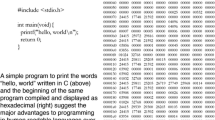Abstract
Object-oriented programming techniques were used to develop computer based data display and storage systems. These have been operating in the 8 anaesthetising areas of the Adelaide Children's Hospital for 3 years. The analogue and serial outputs from an array of patient monitors are connected to IBMTM compatible PC-XT computers. The information is displayed on a colour screen as wave-form and trend graphs and digital format in ‘real time’. The trend data is printed simultaneously on a dot matrix printer. This data is also stored for 24 hours on ‘hard’ disk.
The major benefit has been the provision of a single visual focus for all monitored variables. The automatic logging of data has been invaluable in the analysis of critical incidents. The systems were made possible by recent, rapid improvements in computer hardware and software. This paper traces the development of the program and demonstrates the advantages of object-oriented programming techniques.
Similar content being viewed by others
References
Winter A, Spence AA. An international concensus on monitoring. Br J Anaesth 1990; 64: 263–6.
Prakash O, Jonson B, Mey S, vd Borden S, vd Kolk J, Hugenholtz PG et al. Measurement of cardiopulmonary function during anaesthesia and intensive care. Curr Top Crit Car Med 1977; 3: 60–7.
Prakash O, vd Borden SG, Meij SH, Rulf ENR, Hugenholtz PG. A microcomputer based charting system for documentation of circulatory, respiratory and pharmacological data during anaesthesia. Int J Clin Monit Comput 1984; 1: 155–60.
Roessler P, Brenton MW, Lambert TF. Problems with automating anaesthetic records. Anaesth Intens Care 1986; 14: 443–7.
King PH, Smith BE. An IBM AT-based monitoring system with touch screen input. Int J Clin Monit Comput 1990; 7: 107–11.
Eddleman DW, Tucker DM, McEachern M. A patient monitoring system designed as a platform for application development. Int J Clin Monit Comput 7: 233–40.
Wiener RS, Pinson LJ. An introduction to object-oriented programming and C++. Addison-Wesley Publ. Co U.S.A., 1988.
Sainsbury DA. A Microcomputer based system for the storage and display of physiological variables. Anaesth Intens Care 1988; 16: 75–7.
Nelson PE, Ream AK. Monitor calibration for an automated anesthesia record. In: Gravenstein JS, Newbower RS, Ream AK, Smith NT, editors. The Automated Anesthesia Record and Alarm Systems. Boston: Butterworths, 1987: 63–5.
Feldman JM. Computerised anesthesia recording systems. Adv Anesthesia 1989; 6: 325–54.
Dowling N. Electronic storage of medical records. Australasian J of Medical Defense Union 1992; 6(3): 52–3.
Klocke H, Trispel S, Rau G, Hatzky U, Daub D. An anaesthesia information system for monitoring and record keeping during surgical anaesthesia. J Clin Monit 1986; 2: 246–61.
Philip JH, Thoughtful Alarms. In: Gravenstein JS, Newbower RS, Ream AK, Smith NT, editors. The Automated Anesthesia Record and Alarm Systems. Boston: Butterworths, 1987; 191–201.
Author information
Authors and Affiliations
Rights and permissions
About this article
Cite this article
Sainsbury, D.A. An object-oriented approach to data display and storage: 3 years experience, 25,000 cases. J Clin Monit Comput 10, 225–233 (1993). https://doi.org/10.1007/BF01133013
Accepted:
Issue Date:
DOI: https://doi.org/10.1007/BF01133013




